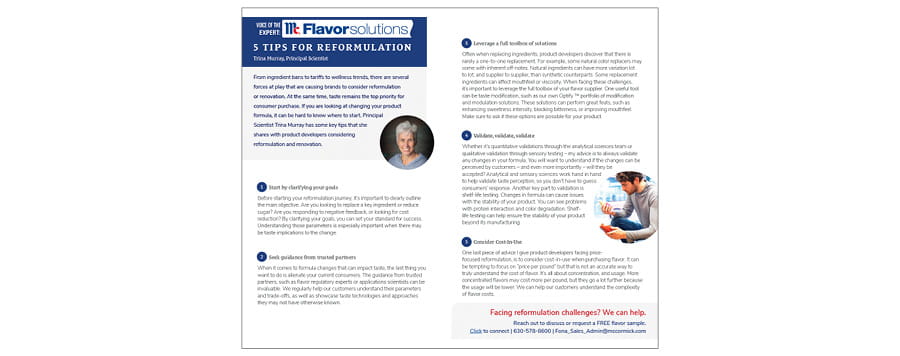Voice of the Expert: 5 Tips for Reformulation
June 16, 2025From ingredient bans to tariffs to wellness trends, there are several forces at play that are causing brands to consider reformulation or renovation. At the same time, taste remains the top priority for consumer purchase. If you are looking at changing your product formula, it can be hard to know where to start. Principal Scientist Trina Murray has some key tips that she shares with product developers considering reformulation and renovation.
1. Start by clarifying your goals
Before starting your reformulation journey, it’s important to clearly outline the main objective. Are you looking to replace a key ingredient or reduce sugar? Are you responding to negative feedback, or looking for cost reduction? By clarifying your goals, you can set your standard for success. Understanding those parameters is especially important when there may be taste implications to the change.
2. Seek guidance from trusted partners
When it comes to formula changes that can impact taste, the last thing you want to do is alienate your current consumers. The guidance from trusted partners, such as flavor regulatory experts or applications scientists can be invaluable. We regularly help our customers understand their parameters and trade-offs, as well as showcase taste technologies and approaches they may not have otherwise known.
3. Leverage a full toolbox of solutions
Often when replacing ingredients, product developers discover that there is rarely a one-to-one replacement. For example, some natural color replacers may come with inherent off-notes. Natural ingredients can have more variation lot to lot, and supplier to supplier, than synthetic counterparts. Some replacement ingredients can affect mouthfeel or viscosity. When facing these challenges, it’s important to leverage the full toolbox of your flavor supplier. One useful tool can be taste modification, such as our own Optify™ portfolio of modification and modulation solutions. These solutions can perform great feats, such as enhancing sweetness intensity, blocking bitterness, or improving mouthfeel. Make sure to ask if these options are possible for your product.
4. Validate, validate, validate
Whether it’s quantitative validations through the analytical sciences team or qualitative validation through sensory testing – my advice is to always validate any changes in your formula. You will want to understand if the changes can be perceived by customers – and even more importantly – will they be accepted? Analytical and sensory sciences work hand in hand to help validate taste perception, so you don’t have to guess consumers’ response. Another key part to validation is shelf-life testing. Changes in formula can cause issues with the stability of your product. You can see problems with protein interaction and color degradation. Shelf-life testing can help ensure the stability of your product beyond its manufacturing.
5. Consider Cost-In-Use
One last piece of advice I give product developers facing price-focused reformulation, is to consider cost-in-use when purchasing flavor. It can be tempting to focus on “price per pound” but that is not an accurate way to truly understand the cost of flavor. It’s all about concentration, and usage. More concentrated flavors may cost more per pound, but they go a lot further because the usage will be lower. We can help our customers understand the complexity of flavor costs.
Download: 5 Tips for Reformulation (PDF)
Reach out to discuss or request a complimentary flavor sample





